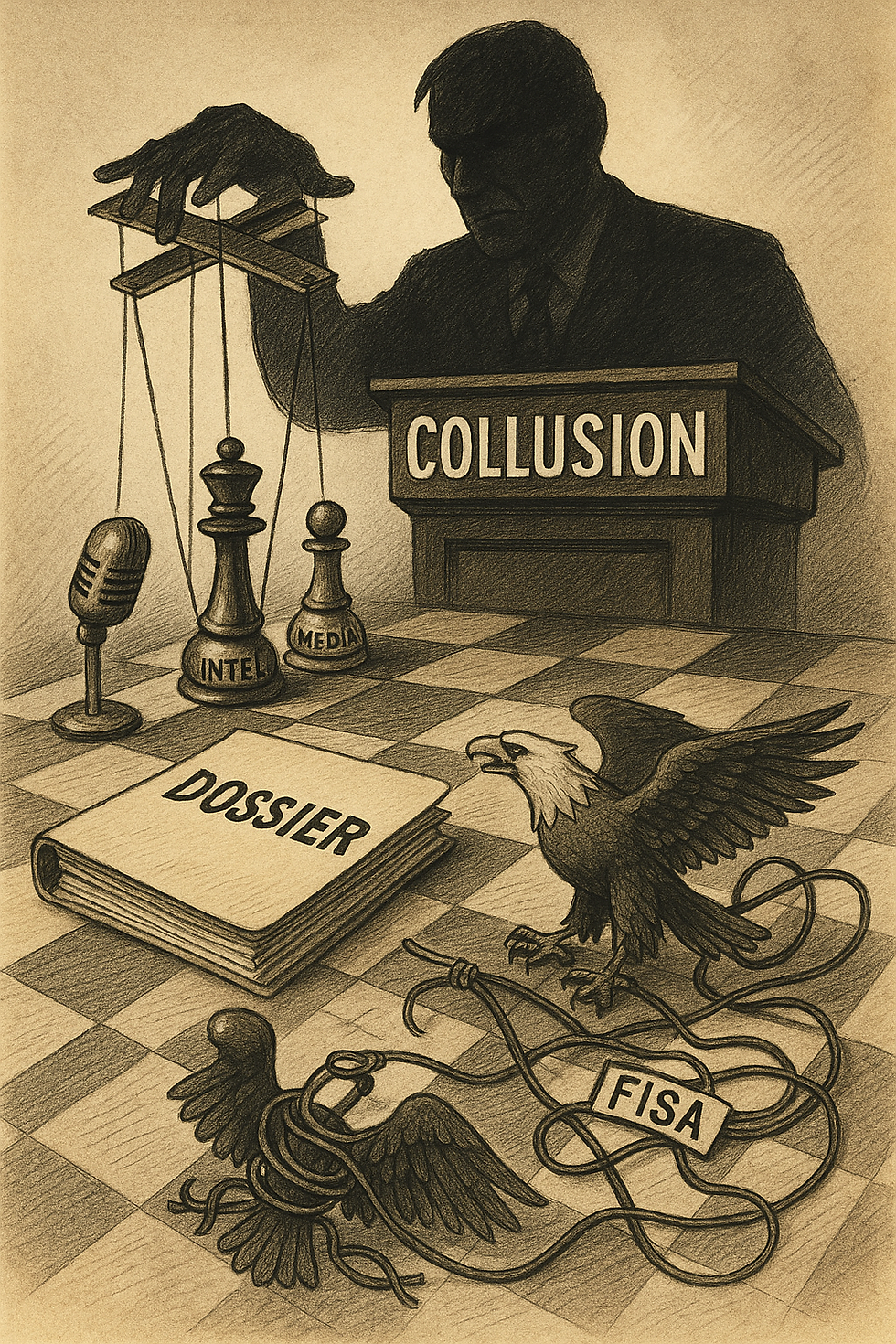How They Framed Trump
- Rick de la Torre

- Jul 21
- 3 min read
The ODNI’s newly released declassified memo and timeline isn’t a side note—it’s a smoking gun. It traces a deliberate path from benign assessment to blockbuster narrative, showing how intelligence on 2016 cyber activity was manipulated for political ends.

Before the election, U.S. intelligence consistently assessed that Russia was “probably not trying…to influence the election by using cyber means.” Pre-election PDBs in September and ICA reports in December found no evidence Putin sought to tamper with vote tallies via cyberattacks. In one internal meeting on September 2, 2016, the FBI even urged the PDB draft to be “softened” to reflect low confidence in claims of electoral impact. By September 9, IC officials signed off on language stating Russia lacked capability to “covertly overturn the vote outcome” via cyber means.
Then on October 7, those conclusions were erased from public facing statements. The FBI and NSA’s low-confidence qualifiers about DNC hacking were scrubbed—replaced with broad claims that Russia “directed” cyberattacks.
After Trump won, the memo confirms, a new clean PDB citing that Russia hadn’t manipulated vote infrastructure was drafted on December 7–8. It included explicit talking points: “Foreign adversaries did not use cyberattacks on election infrastructure to alter the US Presidential election outcome.” Within hours, those get pulled; the FBI dissented, and a senior official killed the PDB citing “new guidance”.
On December 9, the White House principals—Clapper, Brennan, McCabe, Rice, Kerry—met. Clapper’s aide issued a direct tasking: produce an intelligence assessment per the president’s request showing Kremlin influence. Within days, leaks hit The Washington Post and others: Russia used cyber means to influence the outcome—and Trump was the beneficiary.
Then on January 6, 2017, came the “ICA”—a public assessment stating “Putin ordered an influence campaign…We further assess Putin…developed a clear preference for President-elect Trump”. That ICA prevailed in public and political discourse—but the clean PDB was never released.
Why it matters: this isn’t a case of miscommunication or rushed analysis. It was exactly calibrated. It began with clean intel, then mutated into a crackdown narrative through media leaks and executive pressure. Intelligence became a political weapon.
The memo also supports Tulsi Gabbard’s referral of a “treasonous conspiracy” to DOJ, naming Clapper, Brennan, Comey, McCabe and others—accusing them of suppressing critical intelligence and amplifying the Steele dossier to build the case. She provided over 100 pages of declassified records, including the suppressed PDB and White House “tasking” email, and now DOJ is investigating.
Add to this earlier concerns raised in a CIA “lessons‑learned” memo ordered by Ratcliffe, which flagged flaws like rushed processes, reliance on unverified sources, and analytic shortcuts—though it didn’t deny interference existed.
These facts connect directly to the ODNI memo: it wasn’t just sloppy internal analysis. It was an engineered trajectory: start with neutral assessments, replace them with charged intel, leak it selectively, and control the narrative. The result? Intelligence stopped informing and started injuring.
That narrative defined Trump’s first term. He couldn’t engage Russia, couldn’t shift NATO strategy, couldn’t re-examine intelligence assumptions. Every step was preemptively gaslit by the very institutions sworn to inform the president—not undermine him.
Fast forward to 2025. Trump’s back. The suppressed PDB is public. The tasking emails are public. Gabbard made her referral. Senate oversight reforms are in motion. DOJ is investigating. But none of this changes what happened: intelligence was weaponized, clean intel was buried, officials prioritized political damage over national security.
Reform needs to be more than symbolic. We must unblock buried reports and hold decision-makers publicly accountable. We must demand transparency on who retracted clean PDBs, who pushed unverified dossier fragments into court filings, and who leaked them to the media. Anything less is tacit acceptance.
Because when intelligence is shaped by politics—and allowed to influence the presidency—it doesn’t just fail us. It betrays the constitution. The ODNI memo isn’t history. It’s a warning. And if nothing changes, the next time the system will do it again—on purpose.


Comments